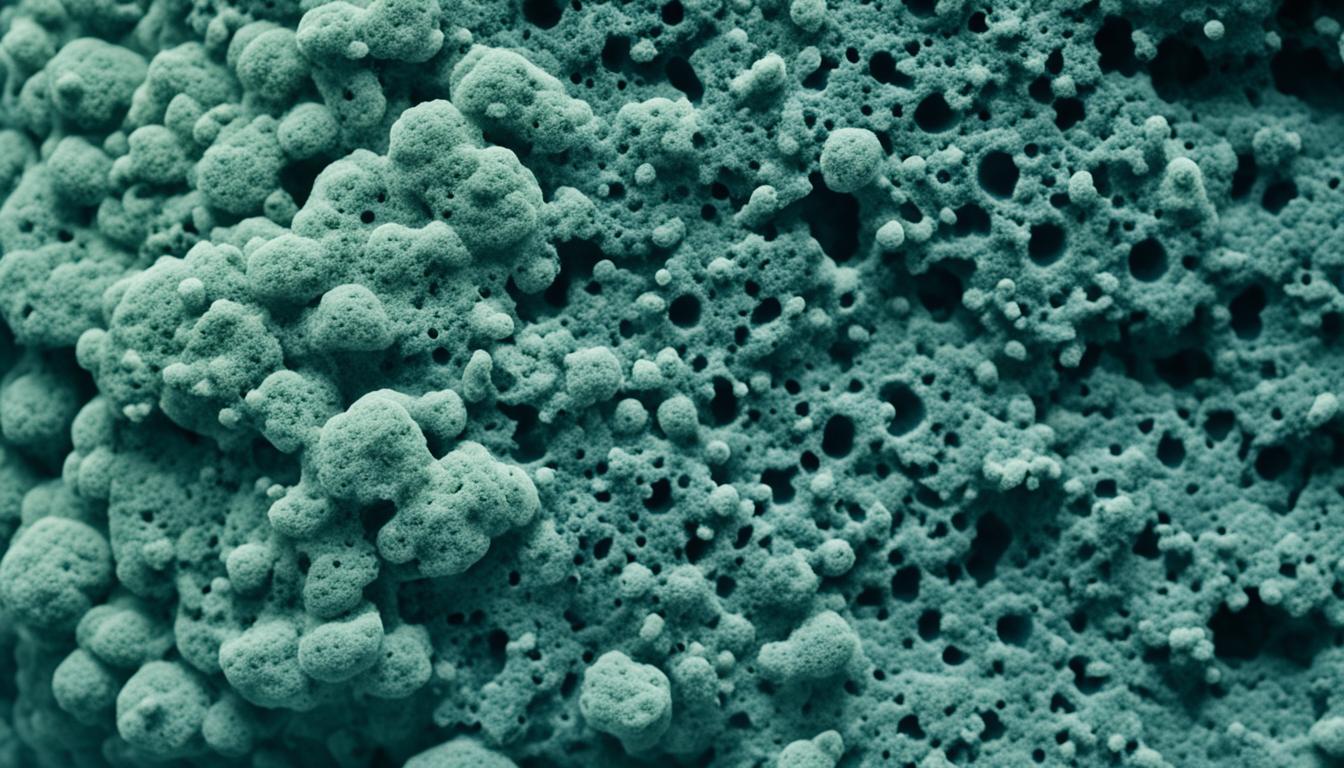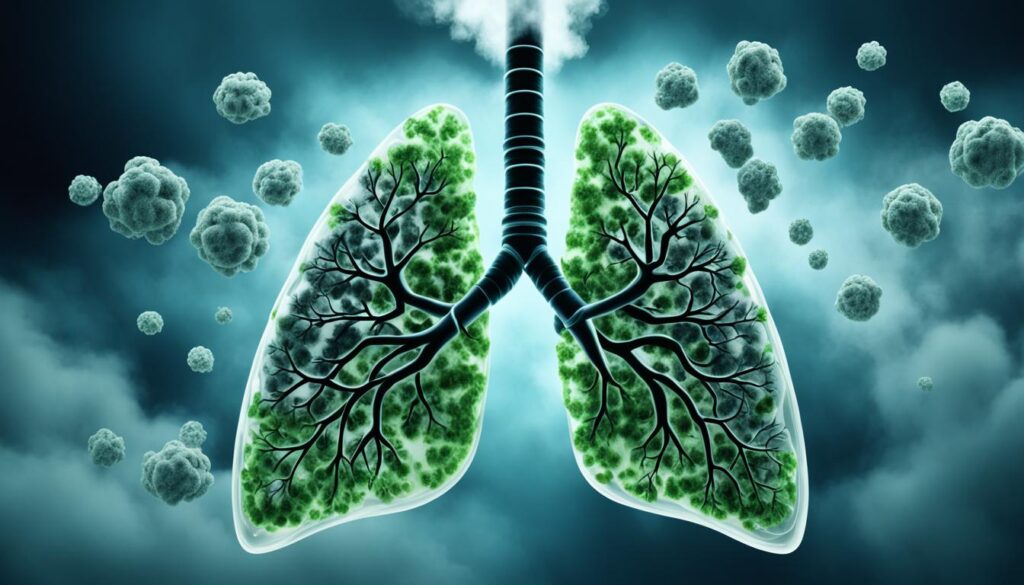
Mold in Lungs: Risks, Symptoms, and Treatment
Welcome to our informative guide on mold in the lungs. In this section, we will explore the health implications of mold exposure and discuss the risks, symptoms, and treatment options associated with this concerning issue. Mold in the lungs can have severe consequences on respiratory health, making it crucial to understand the potential dangers and seek appropriate medical attention when necessary. Let’s delve into the topic and gain valuable insights into how mold can impact our lungs and overall well-being.
Key Takeaways:
- Mold in the lungs can lead to serious health risks and respiratory complications.
- Symptoms of mold in the lungs may include coughing, wheezing, shortness of breath, and chest tightness.
- Seeking prompt medical treatment is essential to manage and alleviate the effects of mold in the lungs.
- Preventing mold growth in the home can help reduce the risk of lung-related issues.
- Regular cleaning and proper ventilation are crucial in maintaining a healthy indoor environment.
Recognizing the Risks and Symptoms of Mold in Lungs
When it comes to mold exposure, the risks to our respiratory health should not be underestimated. Mold spores can be easily inhaled and, when they reach the lungs, can lead to a range of health complications. It is crucial to be aware of the risks and symptoms associated with mold in the lungs so that appropriate action can be taken to address them.
Risks of Mold in Lungs:
- Respiratory Infections: Mold in the lungs can weaken the immune system, making individuals more susceptible to respiratory infections such as bronchitis and pneumonia.
- Allergic Reactions: For those with existing allergies or asthma, exposure to mold in the lungs can trigger severe allergic reactions, leading to difficulty breathing, wheezing, and coughing.
- Fungal Infections: In some cases, mold in the lungs can cause invasive fungal infections, which can be life-threatening if left untreated.
Symptoms of Mold in Lungs:
- Coughing: Persistent coughing that does not seem to go away may indicate the presence of mold in the lungs.
- Shortness of Breath: Difficulty in breathing or a feeling of breathlessness can be a sign that mold has affected the lungs.
- Chest Tightness: A sense of pressure or tightness in the chest can be a symptom of mold-related lung problems.
- Wheezing: Wheezing, or a high-pitched whistling sound when breathing, is a common symptom of mold in the lungs.
- Fatigue: Mold-related lung issues can lead to fatigue and a general feeling of tiredness.
Early recognition of these risks and symptoms is crucial for timely intervention. If you experience any of these symptoms or suspect mold exposure, it is essential to consult a healthcare professional who can provide accurate diagnosis and guide you towards the appropriate treatment.
To visually represent the risks and symptoms of mold in the lungs, refer to the table below:
| Risks of Mold in Lungs | Symptoms of Mold in Lungs |
|---|---|
| Respiratory Infections | Coughing |
| Allergic Reactions | Shortness of Breath |
| Fungal Infections | Chest Tightness |
| Wheezing | |
| Fatigue |

Recognizing these risks and symptoms can help individuals take proactive measures to protect their lung health and seek appropriate medical care when necessary. In the next section, we will explore the available treatment options for mold in the lungs and how they can help individuals regain respiratory well-being.
Effective Treatment Options for Mold in Lungs
When it comes to addressing mold in the lungs, effective treatment options play a vital role in alleviating symptoms and improving overall lung health. Both medical interventions and lifestyle changes are essential in combating the effects of mold exposure and promoting respiratory well-being.
1. Medical Interventions
Medical interventions for treating mold in the lungs may include:
- Antifungal Medications: Prescription antifungal drugs can help eliminate mold-related infections in the lungs. These medications work by targeting and destroying the mold, reducing inflammation, and promoting healing.
- Corticosteroids: In some cases, corticosteroids may be prescribed to reduce inflammation and alleviate respiratory symptoms caused by mold exposure.
- Oxygen Therapy: Individuals with severe respiratory complications may require supplemental oxygen to ensure proper oxygenation of the body and relieve breathing difficulties.
2. Lifestyle Changes
In addition to medical interventions, making certain lifestyle changes can aid in the treatment of mold in the lungs. These changes aim to minimize further exposure and improve lung health:
- Mold-Free Environment: It is crucial to identify and address any sources of mold in the living environment. Professional mold remediation services can effectively eliminate mold and prevent its recurrence.
- Improved Indoor Air Quality: Keep indoor spaces well-ventilated, use air purifiers, and regularly clean and maintain HVAC systems to minimize mold spores in the air.
- Quitting Smoking: Smoking can exacerbate lung issues. Quitting smoking promotes better lung function and improves overall respiratory health.
- Regular Exercise: Regular physical activity boosts lung capacity and strengthens respiratory muscles, enhancing lung health and reducing the impact of mold-related symptoms.
Incorporating a combination of medical interventions and lifestyle changes can offer a comprehensive approach to treating mold in the lungs. It is important to consult with a healthcare professional who can evaluate individual circumstances and provide personalized recommendations for effective treatment.

Conclusion
In conclusion, mold in the lungs poses significant health risks and can cause various symptoms that can negatively impact an individual’s well-being. Mold exposure in the lungs can lead to respiratory issues such as coughing, wheezing, and difficulty breathing. Prolonged exposure may result in more severe conditions, including allergic reactions, asthma exacerbation, and even fungal infections.
It is crucial to be aware of the risks associated with mold in the lungs and to recognize the warning signs early on. If you experience persistent respiratory symptoms or suspect mold exposure, it is essential to seek proper medical evaluation and treatment. Consulting with a healthcare professional who specializes in respiratory health can provide the necessary guidance and support in managing this potentially hazardous situation.
If you require assessments, prevention, or remediation services, it is advisable to contact a reputable provider with expertise in mold-related services. One such trusted provider is Fix Mold Miami, a leading mold remediation company operating in Florida. Fix Mold Miami can be reached at 305-465-6653 and offers comprehensive solutions to ensure a safer and healthier living environment for you and your loved ones.
Safeguarding your respiratory health is of utmost importance. By understanding the risks, being vigilant about early detection, and seeking appropriate treatment and remediation services, you can mitigate the effects of mold in the lungs and maintain optimal lung function for improved overall well-being.




